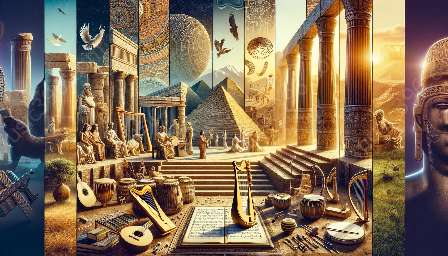Ancient Mesopotamia:
The ancient region of Mesopotamia, often referred to as the cradle of civilization, was home to a rich and diverse musical tradition. Music in ancient Mesopotamia served various cultural, social, and religious purposes, and it was an integral part of everyday life in this ancient civilization.
Main Types of Music in Ancient Mesopotamia:
Ancient Mesopotamian music encompassed a variety of forms and styles, reflecting the multi-faceted nature of the society. Some of the main types of music in ancient Mesopotamia included:
- 1. Religious Music: Music played a central role in religious rituals and ceremonies in Mesopotamia. Priests and musicians performed sacred hymns and chants as part of the worship practices, invoking divine blessings and connecting with the spiritual realm.
- 2. Work Songs: Work songs were prevalent in ancient Mesopotamia, accompanying various labor activities such as farming, weaving, and construction. These songs not only provided rhythmic accompaniment to the work but also fostered a sense of community and solidarity among the laborers.
- 3. Court and Elite Music: Music was patronized by the royal courts and elite classes, where skilled musicians and ensembles entertained the rulers and dignitaries. These performances often featured elaborate compositions and instrumental music, showcasing the sophistication and opulence of the ruling class.
- 4. Popular and Folk Music: Among the common people, folk music and popular songs were an integral part of everyday life. These musical forms reflected the joys, sorrows, and experiences of ordinary individuals, offering a means of expression and communal bonding.
Instruments:
The music of ancient Mesopotamia was accompanied by a wide range of musical instruments, each contributing to the unique sound and aesthetic of the music. Some of the notable instruments included:
- 1. Lyres: The lyre, a stringed instrument with a soundbox and strings, was one of the most prominent instruments in Mesopotamian music. It was used in various contexts, from religious rituals to courtly performances.
- 2. Drums: Percussion instruments, such as frame drums and hand drums, added rhythmic vitality to Mesopotamian music. They provided the beat and accentuated the melodic elements of the music.
- 3. Flutes and Pipes: Wind instruments like flutes and pipes contributed melodic and harmonic elements to the ancient Mesopotamian music, enriching its sonic tapestry.
- 4. Harps and Lutes: Harps and lutes were also prevalent in Mesopotamian music, offering rich and resonant tones that complemented vocal and instrumental performances.
Historical Significance:
The music of ancient Mesopotamia holds immense historical significance, providing valuable insights into the cultural, social, and religious fabric of the ancient civilization. It reflects the artistic achievements and creative expressions of the Mesopotamian people, serving as a testament to their ingenuity and cultural sophistication.
Legacy:
While the ancient Mesopotamian music may seem distant in time, its legacy continues to resonate in the music of subsequent civilizations and cultures. Elements of Mesopotamian music have influenced and inspired musical traditions across the ages, leaving an indelible mark on the history of music.
Exploring the main types of music in ancient Mesopotamia offers a fascinating journey into the musical heritage of one of the world's earliest civilizations, enriching our understanding of music in the ancient world and the broader history of music.




































